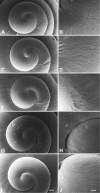Five new cryptic freshwater gastropod species from New Caledonia (Caenogastropoda, Truncatelloidea, Tateidae)
- PMID: 26478699
- PMCID: PMC4602297
- DOI: 10.3897/zookeys.523.6066
Five new cryptic freshwater gastropod species from New Caledonia (Caenogastropoda, Truncatelloidea, Tateidae)
Abstract
During the course of a project aiming at the reconstruction of the colonization of the South Pacific islands by tateid gastropods based on molecular data we discovered five new species on New Caledonia belonging to the genera Hemistomia and Leiorhagium, respectively. We describe these species based on morphological, anatomical and genetic data. All five species are morphologically cryptic as they closely resemble or are even indistinguishable from known species stressing the importance of a comprehensive taxonomic approach integrating several methods. As a consequence of their small and fragmented geographic ranges and the rapidly progressing anthropogenic land cover changes on New Caledonia, all five species qualify as critically endangered according to the criteria of the IUCN.
Keywords: Conservation; IUCN; New Caledonia; South Pacific; Tateidae; cryptic species; endemic; integrative taxonomy; spring snails.
Figures











References
-
- Collado G, Valladares M, Mendez M. (2013) Hidden diversity in spring snails from the Andean Altiplano, the second highest plateau on Earth, and the Atacama Desert, the driest place in the world. Zoological Studies 52: . doi: 10.1186/1810-522X-52-50 - DOI
-
- Delicado D, Ramos MA. (2012) Morphological and molecular evidence for cryptic species of springsnails [genus Pseudamnicola (Corosella)] (Mollusca, Caenogastropoda, Hydrobiidae). Zookeys 190: 55–79. doi: 10.3897/zookeys.190.2555 - DOI - PMC - PubMed
-
- Fregin S, Haase M, Olson U, Alström P. (2012) Pitfalls in comparisons of genetic distances: A case study of the avian family Acrocephalidae. Molecular Phylogenetics and Evolution 62: 319–328. doi: 10.1016/j.ympev.2011.10.003 - DOI - PubMed
-
- Giusti F, Pezzoli E. (1980) Gasteropodi, 2 (Gastropoda: Prosobranchia: Hydrobioidea, Pyrguloidea). Collana Progetto Finalizzato ‘Promozione Quality dell’Ambiente’, Consiglio Nazionale delle Ricerche AQ/ 1147: 1–67.
-
- Haase M. (1996) The radiation of spring snails of the genus Belgrandiella in Austria (Mollusca: Caenogastropoda: Hydrobiidae). Hydrobiologia 319: 119–129. doi: 10.1007/BF00016880 - DOI
LinkOut - more resources
Full Text Sources
Other Literature Sources
Research Materials
